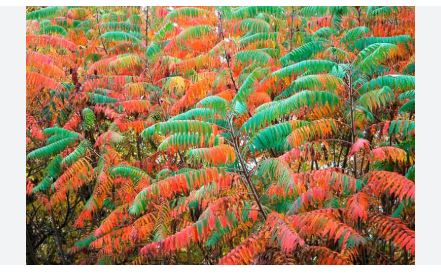
Smooth Sumac (Rhus glabra) is part of the Anacardiaceae family, which includes other notable plants like poison ivy and cashews. Within the Rhus genus, it’s distinguished by its lack of hairiness on young stems, setting it apart from relatives like staghorn sumac.
This species is native to a vast region of North America, spanning from southern Canada through much of the United States, down to northern Mexico. It’s commonly found in prairies, open woodlands, and disturbed areas where it can rapidly colonize.
Historically, Native American tribes utilized Smooth Sumac for various purposes. The berries were used to make a tart drink high in vitamin C, similar to lemonade. The plant was also used for medicinal purposes, with its leaves and bark providing relief for ailments like diarrhea and dysentery. In European colonization periods, it was recognized for its utility in land reclamation and as an ornamental plant.
Smooth Sumac is a deciduous shrub or small tree that can grow up to 15 feet tall. It features compound leaves with numerous leaflets, which turn a brilliant shade of red, orange, or yellow in the fall. Unlike staghorn sumac, its stems are smooth, not hairy. It produces small, greenish flowers in summer, followed by clusters of red berries that persist into winter, offering both ornamental value and food for wildlife.
Smooth Sumac is hardy in USDA Zones 3 through 9, reflecting its wide adaptability to different climatic conditions, from cold winters to hot summers.
With proper conditions, Smooth Sumac can live for many decades, often over 30 years, particularly when it forms dense thickets through its suckering habit. Its longevity is supported by its ability to regenerate from roots following disturbances.
Landscape Uses
Smooth Sumac is valued for several landscape applications:
- Ornamental Use: Its vibrant fall foliage and persistent berry clusters make it an excellent choice for adding autumn and winter interest to landscapes.
- Erosion Control: Its extensive root system makes it ideal for stabilizing slopes and preventing soil erosion, particularly in areas with poor soil quality.
- Wildlife Habitat: The berries are a crucial food source for birds, while the plant provides shelter for numerous species, enhancing local biodiversity.
- Naturalizing: It’s perfect for naturalized areas or large landscapes where its spreading nature can be an asset rather than a liability.
- Screening: Can be used as a living screen or hedge in more informal settings, offering privacy and visual interest year-round.
- Restoration Projects: Often planted in land reclamation efforts due to its ability to grow in challenging conditions.
- Xeriscaping: Its drought tolerance makes it suitable for low-water gardens or xeriscaping designs where water conservation is key.
Smooth Sumac (Rhus glabra): Cultivation
Selecting the Right Location
Choose a site that gets full sun to partial shade. Smooth Sumac flourishes in sunny locations, which promote the best growth and vibrant fall colors. It can tolerate some shade but will be less robust.
Soil Requirements
This plant is highly adaptable to different soil types, including poor, sandy, clay, or gravelly soils. It prefers well-drained conditions but can handle some moisture as well, making it resilient in various environments.
Planting Smooth Sumac
Plant in either spring or fall. Dig a hole slightly larger than the root ball. Place the plant so that the root crown is level with the soil surface, backfill with soil, and water thoroughly to settle the soil around the roots.
Watering
Water young plants regularly until they are well-established. Once mature, Smooth Sumac is drought-tolerant, requiring watering mainly during extended dry periods. Avoid overwatering to prevent root rot.
Spacing
Space plants about 10 to 15 feet apart to account for their mature spread. Remember, Smooth Sumac spreads through suckers, and without management, can form extensive thickets.
Mulching
Apply a layer of mulch around the base of the plant to help maintain soil moisture, suppress weeds, and regulate soil temperature. Mulch should be kept away from the stem to avoid rot.
Pruning
Pruning isn’t often necessary, but if you want to control size or shape, do so in late winter or early spring before new growth. Remove dead or unwanted suckers to manage spread.
Fertilization
Smooth Sumac typically does not require fertilization due to its ability to grow in nutrient-poor soils. If the plant seems to lack vigor, a light application of a balanced, slow-release fertilizer in early spring can help.
Pest and Disease Management
This sumac is relatively resistant to pests and diseases, but watch for aphids or scale insects. Fungal infections like powdery mildew can occur in overly wet conditions; ensure good air circulation to mitigate this.
Propagation
Propagation can be achieved through seeds, which require cold stratification, or by taking root cuttings in late fall. Suckers can also be dug up and transplanted to new areas.
Controlling Spread
Smooth Sumac can spread aggressively through root suckers. To control this, regularly remove unwanted shoots or consider installing root barriers. This is especially important in smaller landscapes or where you want to limit its expansion.
Winter Care
In its hardiness zones, Smooth Sumac is quite cold-resistant. However, in colder regions or for young plants, adding a layer of mulch around the base can offer additional root protection. The plant’s hardy nature means it generally does not need special winter care unless in extreme conditions.